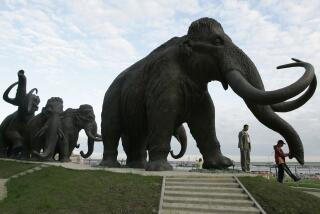Test-Tube Zoos May Hold Key to Species’ Survival : Breeding: Researchers are trying to save endangered animals by controlling their genetic makeup.
In 1983, Betsy Dresser boarded a plane in Los Angeles with delicate cargo taped under her arm: a test tube containing embryos from a rare antelope bred several days earlier at the Los Angeles Zoo.
After the four-hour flight, Dresser delivered the embryos to the Cincinnati Zoo, where they were successfully implanted into two other antelopes, one of them a different species. Two healthy calves were born nine months later and raised by their surrogate mothers.
Dresser’s trip marked the start of what researchers say will one day be standard practice in the breeding of endangered species. Rather than moving animals themselves around the globe, they will be transported as embryos, sperm or eggs. Healthy species may be used to carry the embryos of the endangered.
The trend is part of an increasingly technical approach to saving wildlife from extinction by controlling a population’s genetic makeup. The more genetically diverse a population, the better able it is to fight off disease and reproduce.
But as a species’ number dwindles, animals resort to mating with relatives. This inbreeding can lead to birth defects, reproductive problems and susceptibility to disease.
Using genetic studies and reproductive technology, scientists now are attempting to choose which animals to reproduce based on their bloodlines. An animal that already has several offspring, even if endangered, will not be allowed to mate. Priority is given to animals with few relatives, because its genes are not well represented in a population.
Already, “frozen zoos” are being formed in zoos to store sexually reproductive cells for possible future breeding of rare animals. “You can keep thousands of animals in a small tank, frozen,” said Dresser, research director of the Cincinnati Zoo.
While this high-tech approach may enhance endangered species protection, separate developments in genetic analysis could unwittingly jeopardize it. Recently, for instance, scientists found genetic evidence that indicated the endangered gray wolf in Minnesota mated with coyotes at one time.
Farm groups subsequently challenged the wolf’s endangered classification. As a hybrid, the groups charged, the wolf does not merit protection under the federal Endangered Species Act. The matter is under review.
The growing emphasis on the genetic makeup of populations has vastly changed the way zoos breed animals.
“It’s become an increasingly technical business,” said Bob Seibels, who helps oversee the mating of the endangered Bali myna in captivity throughout North America. “If you had told me before that I would be looking at a computer screen for seven hours of the day, I wouldn’t have believed you. I can actually call up two birds, and the computer will tell me whether they are a good (genetic) match.”
Of all the developments in genetic manipulations of populations, Dresser’s work is probably the most challenging. In one case, the embryo of an endangered Indian desert cat was transferred into a domestic cat. Two kittens were born. One died but the domestic cat raised the other as her own.
Dresser concedes that researchers do not know whether such transfers may somehow alter the endangered animal behaviorally, perhaps interfering with its ability to identify with its own species.
“There hasn’t been enough of this done,” she said. “But these animals grow up and reproduce naturally on their own. You have to suspect that they haven’t changed that much, and indeed, (reproducing naturally) has happened to every one we have tried it on.”
Reproductive technologies such as artificial insemination may one day be effective in maintaining genetic diversity of small, rare tiger populations in India, said Ulie Seal, chairman of the captive breeding group of the International Union for the Conservation of Nature.
For instance, he said, there are 18 tiger reserves scattered over India, with 25 to 50 tigers in each. Although the populations are “way too small for genetic diversity,” moving tigers from one population to another for mating could be risky for the animals. A male tiger in a strange reserve may be quickly killed by another tiger protecting his turf, may wander off the reserve or even kill other tigers, according to Seal.
Reluctant breeders whose genes are nevertheless needed for a small population also could be made to reproduce through the use of artificial insemination and other reproductive technologies. Eventually, zoos might become storehouses of genes that would be transferred to wild populations through embryo transplants or artificial insemination.
“The loss of any individual group of animals will not compromise the survival of the species,” Seal said. “The breeding stock will be available in captivity and will provide as many animals as needed to learn and accomplish the science of reintroduction,” the return of captive-bred wildlife to their original habitat.
But the use of artificial reproductive measures for wildlife remains experimental, largely because of lack of research money. “It is important to realize that it hasn’t saved a single species yet,” Seal added.
Dresser said only four zoos in the world, including San Diego’s, invest in such research, and researchers generally must raise their own money. By contrast, funding for experimenting with similar techniques in domestic livestock for food production has been far easier to obtain.
But the hurdles are more than just financial. It took researchers 15 years to figure out how to remove eggs from a female tiger at the National Zoo in Washington, fertilize them in the laboratory, and then successfully place an embryo into another tiger, Seal said.
In many cases, scientists know little about the reproductive cycles of wildlife. “We don’t know when something as large as a rhinoceros or an elephant comes into heat,” Dresser said. “Strange as it seems, sometimes you can see them breed, but you cannot rely on that.”
In addition to discovering how to breed animals, scientists must learn which to breed. Such decisions are becoming more sophisticated, based increasingly on genetic studies that rely on techniques developed in the past 10 years for humans.
Scientists say these techniques, called DNA fingerprinting or typing, will enable them to prioritize endangered species according to their distinctiveness and the threats they face.
Genetic studies were first done on wildlife in the early 1980s in an attempt to learn why the cheetah was not breeding well in captivity. Stephen J. O’Brien, a geneticist, did the research with some colleagues.
Analyzing blood and skin samples, the researchers discovered that the cheetahs were genetically homogenous, so much alike that a skin graft from one animal would be accepted by another. Inbreeding now is believed to be partly responsible for the cheetahs’ fertility problems.
The scientists theorized that the cheetah population was knocked down to a handful of animals about 10,000 years ago, about the time when many large mammals vanished from much of the planet. The extinction of the large mammals, comparable in some ways to the disappearance of dinosaurs, may have been caused by climatic changes, a meteor or by hunting by early humans.
“Three-quarters of the large mammals of North America disappeared at that time,” said O’Brien, who works at the National Cancer Institute.
He believes that a few cheetahs, which until then had roamed much of the planet, escaped into Africa, the only continent that did not experience the massive extinction. The normal tendency not to breed with close relatives was overcome by the desire to mate.
“Now we are seeing exactly the same thing (inbreeding) in other populations, like the Florida panther, the Asiatic tiger and northern elephant seals,” O’Brien said.
In addition to inbreeding, genetic studies can detect hybridization with other species. In a study of the endangered Florida panther, O’Brien discovered evidence of both hybridization and inbreeding. Mating with other species, or hybridization, can rob an endangered population of its distinctiveness.
Genes passed on by the mother indicated that some Florida panthers mated at one time with South American panthers that had been released in the state. A similar genetic analysis of the endangered gray wolf in Minnesota by other scientists also found evidence of hybridization in that endangered species.
The discoveries have prompted the U.S. Fish and Wildlife Service to reevaluate whether the Endangered Species Act protects hybrids. Previously, the service has ruled that hybrids are not sheltered by the law.
The review has fallen to James Tate Jr., a wildlife biologist in the service’s endangered species division. Although the agency’s position has not been made public, it is expected to be couched in a way that would allow for continued protection of the gray wolf and the panther without shielding all hybrids.
In some cases, wildlife managers want to remove hybrids from an endangered species’ habitat to prevent breeding that would alter the species’ unique genes, Tate said. But in other cases, biologists prefer to allow breeding with a hybrid to introduce new genes into a dangerously genetically homogenous population.
Tate warns that a rigid policy protecting hybrids of endangered species could have unforeseen and unfortunate consequences. What if a pest insect hybridized with an insect on the endangered species list? Could that hybrid pest be killed?
The U.S. Fish and Wildlife Service’s new policy, expected to be made public within a month, will undergo public hearings before becoming law. Farm groups and others critical of the Endangered Species Act probably will continue to argue that evidence of hybridization should disqualify species for endangered protection.
“The Endangered Species Act is up for reauthorization in ’92 and a lot of people are already positioning themselves,” Tate noted.
But the researchers whose work uncovered the evidence of hybridization have argued that the species should continue to be legally protected.
The gray wolf, for instance, “is all the more endangered because there are other species around that can hybridize with it,” said Robert Wayne, a UCLA research associate who did the genetic analysis, called mitochondrial DNA typing, of the wolf.
As a result of these new techniques in genetic analysis, captive breeding of animals is changing. Animals that previously were thought to be of the same species, such as the Bornean and Sumatran orangutans, have been shown to be distinct. They are no longer bred together.
Lloyd Kiff, an ornithologist who heads the California condor recovery team, said he believes many of the threats to wildlife, including loss of habitat, may one day be removed as values and government policies change.
“If we can just limp some of these species through this period, eventually they can come back,” he said. “So on one hand, I see these things (genetic manipulations of populations) as holding actions. On the other, they may almost certainly lead to great breakthroughs and technologies in captive breeding.”
More to Read
Sign up for Essential California
The most important California stories and recommendations in your inbox every morning.
You may occasionally receive promotional content from the Los Angeles Times.











